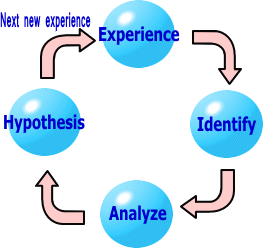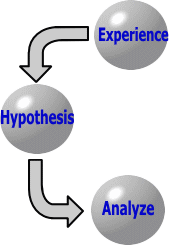
gExperience Learningh (officially, it is called Experience Learning through
Laboratory Method)
refers to a learning technique that focuses on acquiring knowledge and skills from experiences,
and it is usually conducted in the manner of group work exercises.
Experience Learning takes place in a four-step process illustrated below,
and the process is named
gCircular Process of Experience Learning.h
 |
|
Begins with an experience. |
| |
|
|
 |
|
Identifying and isolating incidences from the Step 1 in order to
pick out those that fit the purpose of the leaning. |
| |
|
|
 |
|
Analyze backgrounds and reasons of the incidences picked up in
the Step 2. |
| |
|
|
 |
|
Based upon the analysis in the Step 3, this step develops action/behavior
plans by attempting to act out the next potential circumstances. |
An illustration of the Circular Process of Experience Learning is shown
below.
Circular Process of Experience Learning and the Importance of Reflection
Period
In general, when a person experiences something, he/she develops a hypothesis
from
the outcome of the experience and then analyzes its rationale. On the one
hand,
when the outcome of an experience is negative, one may hypothesize and
analyze
the outcome as:
gI
was never good at doing this from the beginning,h or;
gthere was a problem in the process. The outcome would have been different if I had
done it my way.h
On
the other hand, if the outcome of the experience was positive, he/she may
suggest:
gLeadership
was demonstrated to its fullest extent,h or;
genough
time was spent on analyzing information.h
As demonstrated in the above examples, the Circular Process of Experience
Learning
often flows in the opposite direction.
When the circular process operates in the opposite direction, new insights
and
discoveries are seldom acquired. In order to deepen the learning process, there
is a need to identify and isolate incidences that occurred within the
gexperienceh
collectively or individually (identify), and to study the backgrounds,
causes and
rationales for those incidences (analyses).
Furthermore, a single experience frequently leads to different impressions
and
insights depending on the individual who experiences it.
By surfacing these individual differences, the learning deepens and the
potential for
new insights both about the group itself and the individual themselves
increase.
Therefore, gExperienceh turns into learning through the process of gIdentify,h gAnalysis,h and
gHypotheses.h At the actual site of the Experience Learning, the experiences
during the
exercises are followed by periods of gidentify,h ganalysis,h g hypotheses,h
and greflection.h
As such, the extent to which the period of greflectionh is utilized holds
the key to the
significance of the whole exercise.
The exercise and gexperienceh without greflectionh is considered merely
as a game, and
differs considerably from the process of Experience Learning. In a similar
manner, a greflectionh
without adequate time allocation also remains inconclusive for members
who took part in the
exercise.
However, the more energetic the greflectionh period becomes, there will
be less time for other
aspects of the exercise. It is important, therefore, to allocate more
time for greflectionh period
in comparison to other periods at the planning stages.
The Role of the Facilitator and the
Process
An individual in charge of the training is called a gfacilitator.h He/she
is responsible for enhancing,
deepening, and supporting the learning process. The attitude of the facilitators
and their manner
of their conduct must be open, passive, and sympathetic, and these behaviors are usually derived
from his/her confidence and trust towards other people.
At
the site of the training, it is important for facilitators to observe group
members.
This observation is central, not necessarily for the purpose of guiding members to their target
goal (contents), but more for noting the things that are going on within the group (process).
It is important to observe, for example, how have groups have dealt with
the individuals
who are not sufficiently involved in the process of decision-making and
target achievement;
how minority suggestions were being dealt with; what were the methods of decision-making
(perhaps only few were making decisions but suggesting them to be the
groupfs);
how were emotions of the members dealt with within the group, et
cetera.
The observation of the gprocessesh is important because they are rarely detected in comparison
to the gcontentsh that could easily be surfaced, and, as such, the gprocessesh
often represent the
reality of the groups.
Within the contemporary society also, the handlings of these gprocessesh
determine motivation of
the individuals as well as the end outcome and results.
For facilitators, the process of gidentifyh and ganalysish during the reflection
period are of
particular importance. While following the larger aim of the training, the facilitators must rely on
their observation to surface specific instances during group work, and
facilitate members to search
causes and rationales for such instances.
It is important to keep in mind that the gprocessh is continually changing.
It is a role of the facilitators
to pick up instances during the exercise, but it is also necessary for
them to simultaneously attend
the gprocessh that occurs in the aftermath of the exercise.
They must pay attention to the gprocessh during the reflection period, as well as the gap between
the processes during the exercise and reflection period, and surface the gap when they arise.
By involving ourselves in the gprocess,h we energize individualsf enthusiasm
and motivation, and
hold ourselves responsible for the end outcome and results.
The possibilities for the reforming the work environment within organizations
lie in these
understandings of the gprocessh also.


